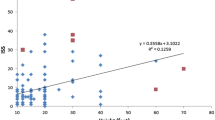Abstract
Purpose
Fall from a height is high energy trauma. The causes include both accidental falls and suicide attempts. The literature and also our previous study demonstrated that this kind of patients, during their recovery time, need a high multidisciplinary workload with significant costs. The present study is the first researching the patterns of the non-acute orthopedic complications after a trauma precipitation that required a new hospitalization and surgical procedure.
Methods
Retrospective study and analysis of orthopedic complication characteristics of patients fallen from height. We researched the possible relation between the complication pattern (soft tissue or bone involvement) and the case character (psychiatric or non-psychiatric patients, type of fracture and kind of fixation).
Results
The 18.83% of all patients (154 cases included) needed a new admission to perform further surgical procedures (9.74% of psychiatric patients and 9.09% of unvoluntary victims). Our data showed that patients with psychiatric disorder were associated with a statistically significant (p < 0.05) increase in soft tissue complications (46.67%) and onset of non-union after internal osteosynthesis and external fixation (72.72%), respectively.
Conclusion
According to the results obtained, we can conclude that osteosynthesis in psychiatric patients is related to well-defined and predictable complications.
Similar content being viewed by others
References
Mosenthal AC, Livingston DH, Elcavage J et al (1995) Falls: epidemiology and strategies for prevention. J Trauma 38:753–756
Richter D, Hahn MP, Ostermann PA, Ekkernkamp A, Muhr G (1996) Vertical deceleration injuries: a comparative study of the injury patterns of 101 patients after accidental and intentional high falls. Injury 27(9):655–659
Faggiani M, Aragno E, Aprato A, Rosso G, Conforti LG, Maina G, Massè A (2020) Falls from height: orthopaedic and psychiatric evaluation. Acta Biomed 91(4-S):79–84. https://doi.org/10.23750/abm
Türkoğlu A, Sehlikoğlu K, Tokdemir M (2019) A study of fatal falls from height. J Forensic Leg Med 61:17–21
Dekker L, Heller HM, Van der Meij JE, Toor AE, Geeraedts LMG (2019) A mixed psychiatric and somatic care unit for trauma patients:10 years of experience in an urban level I trauma center in the Netherlands. Eur J Trauma Emerg Surg 49:1159–1165
Zatzick DF, Kang SM, Kim SY et al (2000) Patients with recognised psychiatric disorders in trauma surgery: incidence, inpatient length of stay, and cost. J Trauma 49(3):487–495
Omi T, Ito H, Riku K et al (2017) Possible factors influencing the duration of hospital stay in patients with psychiatric disorders attempting suicide by jumping. BMC Psychiatry 17(1):99
Van Basten BM, Houben IB, Blokhuis TJ (2019) The non-union scoring system: an interobserver reliability study. Eur J Trauma Emerg Surg 45(1):13–19. https://doi.org/10.1007/s00068-017-0796-4
Sigmund IK, Dudareva M, Watts D, Morgenstern M, Athanaus NA, McNally MA (2020) Ilizarov treatment protocols in the management of infected nonunion of the Tibia. Jt J. 102-B(7):904–911. https://doi.org/10.1302/0301-620X.102B7.BJJ-2019-1739.R1
Buckey RE, Moran GC, Apivatthakakul T (2017) AO principles of fractures management, 3rd edn. Thieme, New York
Kates SL, Borens O (2017) Principles of orthopedic infection management, 1st edn. Thieme, New York
Govaert GAM, Kuehl R, Atkins BL, Tampuz A, Morgenstern M, Obremskey WT, Verhofstad MHJ, McNally MA, Metsemakers WJ, Fracture Related Infection (FRI) Consensus Group (2020) Diagnosing fracture-related infection: current concepts and recommendations. J Orthop Trauma 34(1):8–17. https://doi.org/10.1097/BOT.0000000000001614
Piazzalunga D, Rubertà F, Fugazzola P, Allievi N, Ceresoli M, Sefano Magnone S, Pisano M, Coccolini F, Tomasoni M, Montori G, Ansaloni L (2020) Suicidal fall from heights trauma: difficult management and poor results. Eur J Trauma Emerg Surg 46:383–388. https://doi.org/10.1007/s00068-019-01110-8
Hall S, Myers MA, Ahmed-Ramadan Sadek AR, Baxter M, Griffith C, Dare C, Shenouda E, Nader-Sepahi A (2019) Spinal fractures incurred by a fall from standing height. Clin Neurol Neurosurg 177:106–113
Rocos B, Acharya M, Chesser TJS (2015) The pattern of injury and workload associated with managing patients after suicide attempt by jumping from a height. Open Orthop J 9(395–398):395
Papadakis SA, Pallis D, Galanakos S, Georgiou DF, Kateros K, Macheras G, Sapkas G (2020) Falls from height due to accident and suicide attempt in Greece. A comparison of the injury patterns. Injury 51:230–234
Forrester JD, Yelorda K, Tennakoon L, Spain DA, Staudenmayer K (2019) BASEjumpinginjuries presenting to emergency departments in the United States: an assessment of morbidity, emergency department, and inpatient costs. Wilderness Environ Med 30(2):150–154
Peyron PA, Margueritte E, Baccino E (2018) Suicide in parachuting: a case report and review of the literature. Forensic Sci Int 286:e8–e13. https://doi.org/10.1016/j.forsciint.2018.03.006
Murray CJ, Lopez AD (1997) Alternative projections of mortality and disability by cause 1990–2020: Global Burden of Disease Study. Lancet 349(9064):1498–1504
Tustanowski J (2009) Effect of dressing choice on outcomes after hip and knee arthroplasty: a literature review. J Wound Care 18:449–450
Pelet SCM, Denault A, Provost J (2012) Reduction of tape blisters after hip surgery—a prospective evaluation of three kinds of bandages. J Bone Jt Surg (Br) 94(XXXVIII):164
Burke NG, Green C, McHugh G, McGolderick N, Kilcoyne C, Kenny P (2012) A prospective randomized study comparing the jubilee dressing method to a standard adhesive dressing for total hip and knee replacements. J Tissue Viability 21(3):84–87
Paley D et al (2010) Biomechanical analysis of the Ilizarov external fixator. Eur Phys J Conf. https://doi.org/10.1051/epjconf/20100621002
Funding
None.
Author information
Authors and Affiliations
Corresponding author
Ethics declarations
Conflict of interest
The authors declare that they have no conflict of interest.
Additional information
Publisher's Note
Springer Nature remains neutral with regard to jurisdictional claims in published maps and institutional affiliations.
Rights and permissions
About this article
Cite this article
Faggiani, M., Petruccelli, E., Conforti, L.G. et al. Fall from heights: possible factors influencing the onset of complications. Musculoskelet Surg 106, 297–301 (2022). https://doi.org/10.1007/s12306-021-00701-2
Received:
Accepted:
Published:
Issue Date:
DOI: https://doi.org/10.1007/s12306-021-00701-2




